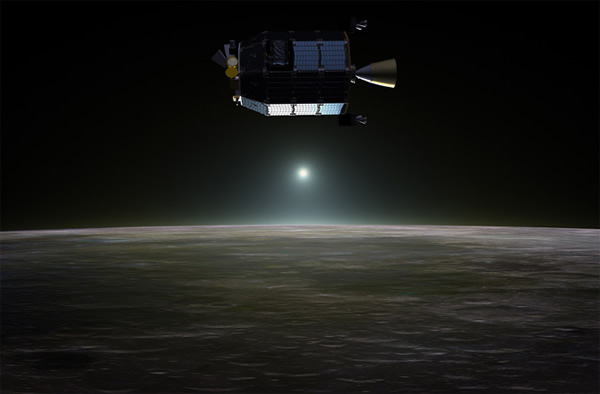China Moon Landing a Boon for NASA LADEE Science
Artist's impression of NASA's LADEE probe orbiting the moon.
A NASA spacecraft that last month began measuring gases and dust coming off the surface of the moon got a science bonus this weekend with the arrival of China’s Chang’e 3 lander and Yutu rover.
"This is very interesting to us because we know how much hydrazine and nitrogen tetroxide is being released," by Chang'e 3, said Richard Elphic, project scientist for NASA’s Lunar Atmosphere and Dust Environment Explorer, or LADEE.
The chemicals, used by Chang’e 3’s landing engine, produce some “interesting species that we’d like to track, one of them being water,” Elphic said at the American Geophysical Union conference in San Francisco on Friday.
Saturday morning, China became only the third nation in history to soft-land a spacecraft on the moon, a feat that had not been accomplished since the former Soviet Union’s Luna 24 mission touched down in 1976 to drill out soil samples and fly them back to Earth.
Tracking water on the lunar surface could help scientists understand the process by which ice ended up in permanently shadowed craters in the moon’s poles.
“Water’s migration across the surface either happens or it doesn’t,” Elphic said. “It may be able to hop across the surface and if it does it has ramifications for the sequestration of ice at the lunar poles. It’s one pathway.”
LADEE looked for signs of Chang’e 3’s arrival into lunar orbit on Dec. 6, which also required a thruster burn, but did not see anything.
So far, LADEE, which began collecting science data on Nov. 20, has found unexpectedly large amounts of dust flying off the lunar surface, including what appears to be dust plumes scientists believe are due to a meteoroid impact.
“As soon as we opened the cover on LDEX (the Lunar Dust Experiment instrument) they began seeing dust impacts on the instrument. Even in our 250-kilometer (155-mile) altitude orbit, they were seeing roughly one impact per minute, maybe a little less, as they circled the moon.
“They were so stunned by those initial impacts that they wanted us to turn the instrument around, face in the opposite direction, so they couldn’t possibly see any dust impacts on the instrument and indeed they saw nothing, so the instrument was clearly operating as designed,” Elphic said.
Impact rates increased as LADEE dipped to lower altitudes. The probe flies in an elliptical orbit that comes as close as 15 kilometers (nine miles) to the lunar surface.
Scientists also noticed that LDEX occasionally sees very high rates of dust impacts.
“We think this was because LADEE was flying through an impact plume resulting from a meteoroid landing on the surface of the moon somewhere nearby. I don’t know how close nearby it has to be in order to see this, but certainly within a few tens of kilometers, up out to about 100 kilometers,” Elphic said.
In addition to studying dust lifting off the lunar surface, LADEE is monitoring the thin shell of gases enveloping the moon, a tenuous atmosphere known as an “exosphere.”
LADEE was launched on Sept. 8 and put itself into orbit around the moon on Oct. 6. Its mission had been slated to end in early March, but is likely to be extended until March 25, Elphic said.
“We’re basically in good shape. All the instruments are running great. The spacecraft is a little champ. It’s doing wonderfully,” he said.(Dec 17, 2013 02:18 PM ET // by Irene Klotz)












